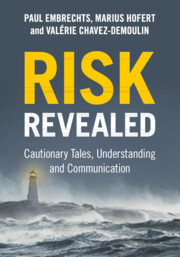Book contents
- Frontmatter
- Dedication
- Contents
- Preface
- Introduction
- 1 The 1953 Great Flood
- 2 The Space Shuttle Challenger Disaster
- 3 The 2007–2008 Financial Crisis
- 4 Earthquakes and Tsunamis
- 5 The L’Aquila Trial and the Public Communication of Risk
- 6 The Coronavirus Pandemic
- 7 Mathematical Wonderland
- 8 Stochastic Modeling
- 9 The Modeling of Extreme Events
- 10 On Climate Change and Related Risk
- 11 Further Examples from the World of Extremes
- 12 Networks
- 13 The Black Tulip and February 3, 1637
- A Note About the References
- References
- Index
13 - The Black Tulip and February 3, 1637
Published online by Cambridge University Press: 05 April 2024
- Frontmatter
- Dedication
- Contents
- Preface
- Introduction
- 1 The 1953 Great Flood
- 2 The Space Shuttle Challenger Disaster
- 3 The 2007–2008 Financial Crisis
- 4 Earthquakes and Tsunamis
- 5 The L’Aquila Trial and the Public Communication of Risk
- 6 The Coronavirus Pandemic
- 7 Mathematical Wonderland
- 8 Stochastic Modeling
- 9 The Modeling of Extreme Events
- 10 On Climate Change and Related Risk
- 11 Further Examples from the World of Extremes
- 12 Networks
- 13 The Black Tulip and February 3, 1637
- A Note About the References
- References
- Index
Summary
We have reached the end of our stroll. We find ourselves in the company of Alexandre Dumas who, in 1850, wrote “The Black Tulip”. In it, he combines the stories of the tulip mania in the Netherlands with the tragic story of the brothers de Witt. In our final example of “About the data” we reconstruct the historic trading data of tulip bulbs, which turns out to be a detective story in its own right. Prices for tulip bulbs crashed on February 3, 1637. We also include the story of the growing of the first black tulip in 1986. Johan de Witt was tragically lynched by a politically motivated mob on August 20, 1672. With him, we meet a politician who, through his mathematical training, was able to solve an important problem from the realm of life insurance risk, the pricing of annuities. His publication “Waerdye” is our final example on risk communication. We leave the closing lines of our book to Shakespeare’s Hamlet, who spoke the following words to Horatio “There are more things in heaven and earth, Horatio, than are dreamt of in your philosophy.” We hope that we were able to convince you that these words very much apply to the realm of risk.
Keywords
- Type
- Chapter
- Information
- Risk RevealedCautionary Tales, Understanding and Communication, pp. 337 - 344Publisher: Cambridge University PressPrint publication year: 2024

